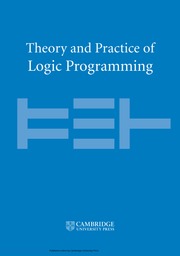Article contents
A Proof Theoretic Study of Soft Concurrent Constraint Programming
Published online by Cambridge University Press: 21 July 2014
Abstract
Concurrent Constraint Programming (CCP) is a simple and powerful model forconcurrency where agents interact by telling and asking constraints. Since theirinception, CCP-languages have been designed for having a strong connection tologic. In fact, the underlying constraint system can be built from a suitablefragment of intuitionistic (linear) logic -ILL- and processes can be interpretedas formulas in ILL. Constraints as ILL formulas fail to represent accuratelysituations where “preferences” (called soft constraints)such as probabilities, uncertainty or fuzziness are present. In order tocircumvent this problem, c-semirings have been proposed as algebraic structuresfor defining constraint systems where agents are allowed to tell and ask softconstraints. Nevertheless, in this case, the tight connection to logic and prooftheory is lost. In this work, we give a proof theoretical meaning to softconstraints: they can be defined as formulas in a suitable fragment of ILL withsubexponentials (SELL) where subexponentials, ordered in a c-semiring structure,are interpreted as preferences. We hence achieve two goals: (1) obtain a CCPlanguage where agents can tell and ask soft constraints and (2) prove that thelanguage in (1) has a strong connection with logic. Hence we keep a declarativereading of processes as formulas while providing a logical framework forsoft-CCP based systems. An interesting side effect of (1) is that one is alsoable to handle probabilities (and other modalities) in SELL, by restricting theuse of the promotion rule for non-idempotent c-semirings.This finer way ofcontrolling subexponentials allows for considering more interesting spaces andrestrictions, and it opens the possibility of specifying more challengingcomputational systems.
Information
- Type
- Regular Papers
- Information
- Theory and Practice of Logic Programming , Volume 14 , Special Issue 4-5: 30th International Conference on LogicProgramming , July 2014 , pp. 649 - 663
- Copyright
- Copyright © Cambridge University Press 2014
References
- 7
- Cited by

